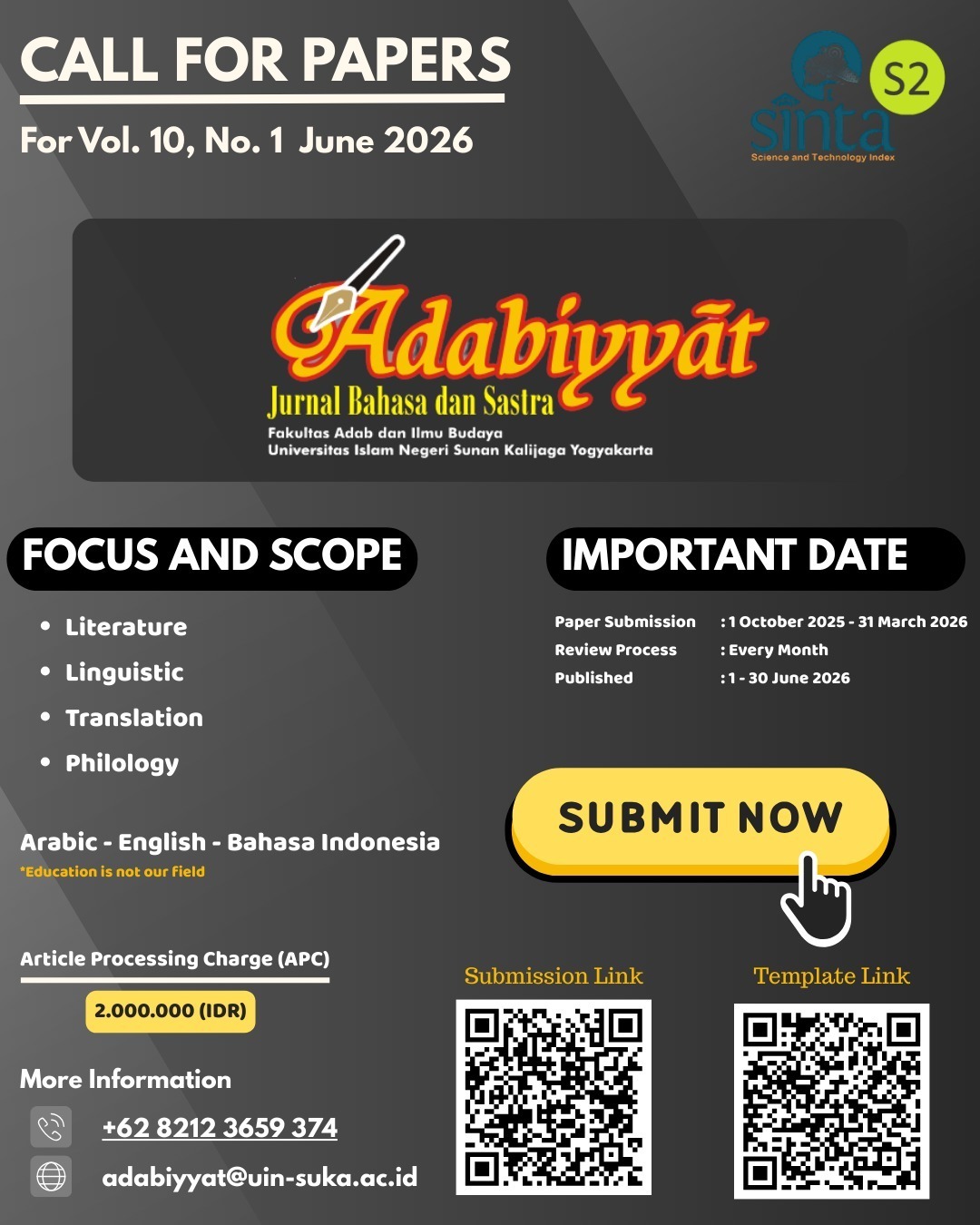KLITIK –NYA DALAM BAHASA INDONESIA
DOI:
https://doi.org/10.14421/ajbs.2012.11106الملخص
The –nya clitic is discussable in terms of not only microlinguisctic domains (phonology, morphology and syntax) but also macrolinguistic perspectives like pragmatics and sociolinguistics. In terms of microlinguistics, there are three important findings of the –nya clitic structure : it can appear (a) as a genitive form, (b) as a definite marker, and (c) as a third person pronoun attached to different word categories (verbs, adjectives, and adverbs). Pragmatically speaking, the –nya clitic can distinguish ‘the old information’ from ‘the new one’ overtly and covertly. From the sociolinguistic point of view the –nya clitic is functioned to avoid the use of the second person that directly threatens the interlocutor’s face. The –nya clitic is also used to measure the degree of closeness between the addresser and the addressee (speech participants): the use of -nya indicates closer relationship (as in bukunya mana?), whereas the use of second person forms indicates formality (as in Dimana Buku Anda?). In informal situations, the speaker tends to choose the third person–nya as a marked form instead of the second person forms such as Anda, kamu, Saudara, Bapak, Ibu, and Dik, which are unmarked. Therefore, the –nya clitic is grammatically, pragmatically, and sociolinguistically very dynamic in different speech registers.
التنزيلات
المراجع
Anderson, S. R. 1985. “Inflectional Morphology.” In Timothy Shopen (ed.). Language Typology and Syntactic Description. Cambridge: Cambridge University Press.
Anderson, S. R. 2007. “English Reduced Auxiliaries Really are Simple Clause.” http://bloch.ling.yale.edu/Files/IATL-USletter.pdf. Diunduh dari internet 30 April 2009
Anderson, S. R. 2009. “Second Position Cltics in Tagalog.” http://bloch.ling.yale.edu/Files/Tagalog_PKFestcrift.pdf. Diunduh dari internet, 30 April 2009.
Cartier, A. 1989. “Kalimat Berverba Transitif yang Mengalami Pemudaran Diatesis di dalam Bahasa Indonesia Ragam Formal.” Dalam Bambang Kaswanti Purwo (ed.). Serpih-serpih Telaah Pasif Bahasa Indonesia. Jakarta: Kanisius.
Chomsky, Noam. 1965. Aspects of the Theory of Syntax. Cambridge, Massachusetts: The M. I. T. Press.
Dardjowidjojo, S. 1983. Beberapa Aspek Linguistik Indonesia. Jakarta: Penerbit Djambatan.
Foley, W. A. 1997. Anthropological Linguistics: An Introduction. Malden and Oxford: Balackwell Publisher.
Himmelmann, N.P. 2005. “The Austronesian Languages of Asia and Madagascar: Typological Characteristics.” In Alexander Adelaar and Nikolaus P. Himmelmann. The Austronesian Languages of Asia and Madagascar. London and Newyork: Routledge.
Hopper, P.J. 1979. “Aspect and Foregrounding in Discourse.” Dalam Talmy Givon, ed., Discourse and Syntax. New York: Academic Press 213—241.
Hopper, P.J and E.C. Traugott. 1993. Grammaticalization. Cambridge: Cambridge University Press.
Kroeger, P.R. 2004. Analysing Syntax: A Lexical-Functional Approach. Cambridge: Cambridge University Press.
Katamba, F. 1993. Morphology. London: Macmillan Press LTD.
Lambrecht, K. 1994. Information Structure and Sentence Form. Camcridge: Cambridge University Presss.
Moeliono, A.M. (dkk.). 1988. Tata Bahasa Baku Bahasa Indonesia. Jakarta: Balai Pustaka.
Pastika, W and Phil Quick. 2007. “Comparing Transitive Constructions in Balinese and Pendau.” In Iwasaki Shoichi at.al (eds.). Pacific Linguistics (E-3). Canberra: RSPAS, ANU.
Pastika, I Wayan, 2006. “Bentuk Posesif Bahasa Bali.: Analisis Morfosintaksis dan Etnolinguistik.” Dalam Linguistik Indonesia. Jakarta: Masyarakat Linguistik Indonesia Bekerjasama dengan Yayasan Obor Indonesia. 83—94.
Pastika, I Wayan. 1999. Voice Selection in Balinese Narrative Discourse. Ph.D thesis, Australian National University.
Van Ophuijsen, Ch. A. 1983. Tata Bahasa Melayu. Jakarta: Penerbit Djambatan.
Verhaar, J. W. M. 1982. Pengantar Linguistik. Jogyakarta: Gadjah Mada University Press.
التنزيلات
منشور
إصدار
القسم
الرخصة
- Adabiyyāt: Jurnal Bahasa dan Sastra publishes all articles entirely in full text.
- It is permissible for readers to download and to use it for scientific purposes and scientific dissemination.
- The author can re-publish the article that has been published by the Adabiyyāt: Jurnal Bahasa dan Sastra after obtaining written permission from the editor. This letter can be obtained by submitting a request letter for permission to republish the article to Adabiyyāt: Jurnal Bahasa dan Sastra via email adabiyyat@uin-suka.ac.id. In the second publication, the author is required to include information that the article was firstly published by the Adabiyyāt: Jurnal Bahasa dan Sastra.




















